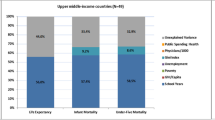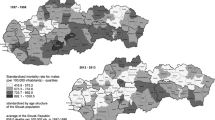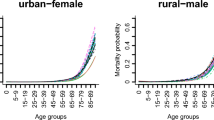Abstract
Aim
The socioeconomic status (SES) in Taiwan has been greatly improved after decades of socioeconomic development. However, health inequality still exists. This study aims to explore the trend of socioeconomic development in three counties which were more impoverished compared to others in central Taiwan during 2000–2015 and to analyze the correlation between SES and health for investigating the existence of geographical health inequalities and related mechanisms.
Subjects and methods
This study examined four independent variables of economic development indicators and three independent variables of social development indicators, as well as the main outcome of standardized mortality rate (SMR) using data from official government publications. Descriptive and panel data analyses were applied and a geographic information system used for visualized presentation of the regional mortality changes.
Results
The results showed that the all-cause SMRs were statistically significantly different within the three counties (p = 0.002). In 2015, the SMR of Yunlin, Nantou, and Changhua were 5.07‰, 5.01‰, and 4.46‰, respectively. We found that the difference in SMRs among townships was not only significant but also increased year by year. Findings from the panel data analysis also suggested that the higher the degree of socioeconomic development, the lower the SMR regardless of the county or township level, and that education was the most important factor.
Conclusion
We can say that there is still health inequality in central Taiwan and we advocate the importance of universal education, especially for the disadvantaged, to achieve the goal of health for all.






Similar content being viewed by others
References
Bor J, Cohen GH, Galea S (2017) Population health in an era of rising income inequality: USA, 1980–2015. Lancet 389:1475–1490
Braveman P, Egerter S, Williams DR (2011) The social determinants of health: coming of age. Annu Rev Public Health 32:381–398
Chang L (2015) Factors associated with poor hospital mortality rates after the National Health Insurance program. Asia Pac J Public Health 27:NP903–NP913
Chetty R, Stepner M, Abraham S, Lin S, Scuderi B, Turner N, Bergeron A, Cutler D (2016) The association between income and life expectancy in the United States, 2001–2014. JAMA 315:1750–1766
Chiang T-L (1999) Economic transition and changing relation between income inequality and mortality in Taiwan: regression analysis. BMJ 319:1162–1165
Gray AM (1982) Inequalities in health. The Black Report: a summary and comment. Int J Health Serv 12:349–380
Haeberer M, Noguer I, Mújica OJ (2015) [Educational inequalities in mortality and survival of women and men in the Americas, 1990–2010]. Rev Panam Salud Publica 38:89–95
Hsiao C (2014) Analysis of panel data. Cambridge University Press, Cambridge
Hsu CC, Lee CH, Wahlqvist ML, Huang HL, Chang HY, Chen L, Shih SF, Shin SJ, Tsai WC, Chen T, Huang CT, Cheng JS (2012) Poverty increases type 2 diabetes incidence and inequality of care despite universal health coverage. Diabetes Care 35:2286–2292
Huisman M, Kunst AE, Bopp M, Borgan JK, Borrell C, Costa G, Deboosere P, Gadeyne S, Glickman M, Marinacci C, Minder C, Regidor E, Valkonen T, Mackenbach JP (2005) Educational inequalities in cause-specific mortality in middle-aged and older men and women in eight western European populations. Lancet 365:493–500
Kagamimori S, Gaina A, Nasermoaddeli A (2009) Socioeconomic status and health in the Japanese population. Soc Sci Med 68:2152–2160
Kawachi I, Kennedy BP (1999) Income inequality and health: pathways and mechanisms. Health Serv Res 34:215–227
Kawachi I, Adler NE, Dow WH (2010) Money, schooling, and health: Mechanisms and causal evidence. Ann N Y Acad Sci 1186:56–68
Kondo N, Sembajwe G, Kawachi I, Van Dam RM, Subramanian SV, Yamagata Z (2009) Income inequality, mortality, and self rated health: meta-analysis of multilevel studies. BMJ 339:b4471
Lynch JW, Smith GD, Kaplan GA, House JS (2000) Income inequality and mortality: importance to health of individual income, psychosocial environment, or material conditions. BMJ 320:1200–1204
Lynch J, Smith GD, Harper S, Hillemeier M, Ross N, Kaplan GA, Wolfson M (2004) Is income inequality a determinant of population health? Part 1. A systematic review. Milbank Q 82:5–99
Marmot M (2005) Social determinants of health inequalities. Lancet 365:1099–1104
Niessen LW, Mohan D, Akuoku JK, Mirelman AJ, Ahmed S, Koehlmoos TP, Trujillo A, Khan J, Peters DH (2018) Tackling socioeconomic inequalities and non-communicable diseases in low-income and middle-income countries under the Sustainable Development agenda. Lancet 391:2036–2046
Omran AR (1971) The epidemiologic transition. A theory of the epidemiology of population change. Milbank Mem Fund Q 49:509–538
Omran AR (1998) The epidemiologic transition theory revisited thirty years later. World Health Stat Q 51:99–119
Park J, Ryu SY, Han MA, Choi SW (2015) The association between income inequality and all-cause mortality across urban communities in Korea. BMC Public Health 15:574
Phelan JC, Link BG, Diez-Roux A, Kawachi I, Levin B (2004) “Fundamental causes” of social inequalities in mortality: a test of the theory. J Health Soc Behav 45:265–285
Singh-Manoux A, Marmot M (2005) Role of socialization in explaining social inequalities in health. Soc Sci Med 60:2129–2133
Szanton SL, Gill JM, Allen JK (2005) Allostatic load: a mechanism of socioeconomic health disparities? Biol Res Nurs 7:7–15
Thompson WS (1929) Population. Am J Sociol 34:959–975
Vathesatogkit P, Batty GD, Woodward M (2014) Socioeconomic disadvantage and disease-specific mortality in Asia: systematic review with meta-analysis of population-based cohort studies. J Epidemiol Community Health 68:375–383
Wang F, Wang JD, Hung YW (2018) Universal health insurance, health inequality and oral cancer in Taiwan. PLoS One 13:e0205731
Wen CP, Tsai SP, Chung WS (2008) A 10-year experience with universal health insurance in Taiwan: measuring changes in health and health disparity. Ann Intern Med 148:258–267
Whitehead M (1992) The concepts and principles of equity and health. Int J Health Serv 22:429–445
Wilkinson RG, Marmot MG (2003) Social determinants of health: the solid facts. Second edition. WHO Regional Office for Europe, Copenhagen
Acknowledgements
I would like to express my special thanks of gratitude to Professor Tung-Liang Chiang, my teacher and mentor in the Master of Public Health Degree Program, National Taiwan University, who gave me the golden opportunity to complete this wonderful master’s thesis on the topic of health inequality and taught me a lot. I would also like to thank my research colleagues (Wan-Lin Chiang, Chug-Tung Kuo, Ying-Hsuan Chen, and Yi-Han Chang), best friends, and my family who helped me a lot in finalizing this study.
Author information
Authors and Affiliations
Corresponding author
Ethics declarations
Ethical approval
The study did not involve human subjects, so ethics approval was not required.
Conflict of interest
The authors declare that they have no conflict of interest.
Additional information
Publisher’s note
Springer Nature remains neutral with regard to jurisdictional claims in published maps and institutional affiliations.
Rights and permissions
About this article
Cite this article
Liu, YT. Associations between socioeconomic development and mortality—a small area panel data analysis in Taiwan, 2000–2015. J Public Health (Berl.) 29, 145–157 (2021). https://doi.org/10.1007/s10389-019-01104-1
Received:
Accepted:
Published:
Issue Date:
DOI: https://doi.org/10.1007/s10389-019-01104-1




